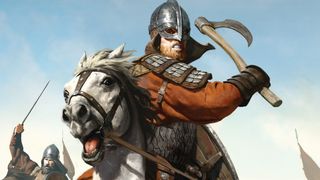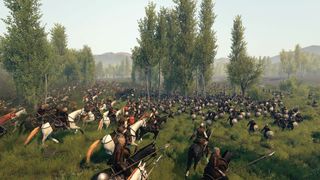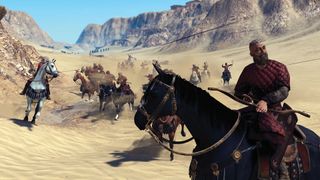Mount and Blade 2 is on a mission to be 2017's best RPG
This exciting sandbox sequel builds on everything the series has done so far.

This article was originally published in PC Gamer issue 302. For more quality articles about all things PC gaming, you can subscribe now in the UK and the US.
Mount & Blade is an unlikely success story of the kind that only really happens on PC. Awkward, weird, and not particularly pretty, it’s nonetheless a triumph of sandbox design. It mixes tactical combat, RPG progression and strategic simulation, all in a sandbox world full of possibilities. In Mount & Blade: Warband, 2010’s standalone expansion and easily the best game in the series so far, players have free rein to explore a massive, politically intriguing medieval kingdom.
Now, after years of waiting, a full sequel is on the way. TaleWorlds’ sizeable, dedicated fan base has been clamouring for Mount & Blade II: Bannerlord ever since its announcement back in 2012. It’s one of my most anticipated games of the year, and I’m excited to find out how it has progressed since the footage shown at last year’s PC Gamer Weekender. TaleWorlds doesn’t disappoint, and I get to watch as community manager Frank Elliott plays through an hour of a new campaign. A new character, Yasmin, is created. She’s spawned into the Southern Empire—a once mighty imperial power, now on the brink of collapse. Bannerlord is set 200 years before Warband, and depicts the early days of some of this world’s great powers. Despite the fictional nations, this is no fantasy land. Weapons, armour and architecture are all designed to resemble historical equivalents from between 600 and 1100 AD.
Character creation is skipped in the demo—TaleWorlds has previously shown off the varied creation sliders, but isn’t ready to detail the full extent of customisation. Needless to say, there should be plenty of options, including new builds that are part of an improved progression system. “Bannerlord’s skill system builds upon what we had in Warband,” says CEO Armagan Yavuz, “but it is vastly improved and in many ways much deeper and more fun. We have traits, skills and perks that work together in an interesting and unique way. Each skill has its own kind of XP category and is exercised individually. For example, you improve the Tracking skill by finding older and more difficult to find tracks.”

Entering the nearby city of Syronaea, Yasmin goes looking for a job. As in Warband, settlements can be traversed on foot, or via a menu. You’re free to explore each town, village and castle, or, if you’re in a hurry, can choose to instantly access essential services. New for Bannerlord, important NPCs can be directly accessed through the menu too, teleporting you to their location to instantly pick up a quest.
Settlements are also where you expand your army. This is an important part of Mount & Blade. You can travel alone, but you’ll be at the mercy of bandits and rival factions. It’s better to have at least a small band of troops.
In Warband, you could visit villages and attempt to rally volunteers to your cause. In Bannerlord, troops are provided by important NPCs.
In Warband, you could visit villages and attempt to rally volunteers to your cause. In Bannerlord, troops are provided by important NPCs. The better your relationship with that person, the more soldiers you’ll receive for your gold. Of course, each major NPC has different desires and allegiances, and working with one may put you at odds with another. Bannerlord isn’t just about building alliances with the people you meet. In most situations you’ll be picking a side, and that will have effects both on the specific people involved and the population at large.
PC Gamer Newsletter
Sign up to get the best content of the week, and great gaming deals, as picked by the editors.
As a new character with no notoriety, Yasmin is only able to acquire a single soldier per each 100 gold she pays. She nevertheless hires a few troops, and accepts a quest from Suterios the Sutler, a local merchant. He has a problem with a local gang of smugglers, who have taken over an alley that could otherwise be used for legitimate market stalls. Yasmin is tasked with clearing them out. This quest ties into what Yavuz describes as a desire to make towns more interesting by adding “opportunities for you to get into trouble.” Towns and villages have back alleys and other areas of interest that are a point of conflict. The controlling faction can change based on your actions—it’s even possible to take ownership of them yourself.
Yasmin’s new troops can’t enter the settlement, and so can’t help clear the alley. Instead, Yasmin heads to the nearby tavern to find mercenaries for hire. These, as in Warband, are named companions with a backstory and special traits. Yasmin chooses Garitops the Golden, a heavy-set cavalryman, and Urios the Bull, a heavy-set swordsman. Less than ten minutes in, and she already has a type.

Companions are more expensive to hire than regular soldiers, but worth it if used effectively. Here, Yasmin has them follow her to the alley as backup. As she approaches, the smugglers stand up for their turf. It’s the usual tough talk between two sides who are readying for a fight, but the smugglers reveal they are friends with the Oath Keepers—a local syndicate. They give Yasmin the option to switch sides—betraying Suterios and the merchants. “We are trying to make it so all quests have multiple ways to resolve them,” Yavuz tells me.
Because of its sandbox nature, Mount & Blade’s quests are procedurally generated around a number of set templates. They can have a great effect on the overall story of your campaign, but no individual quest ever felt like a compelling story by itself. Not only is Bannerlord attempting to increase the complexity of these scenarios, but their generation is now based on what’s happening out in the world. That means you’ll only get a quest to hunt down bandits if a settlement has a bandit problem. Everything is tied more fully into the sandbox. That’s important, because the simulation is the story. The narrative emerges based around your actions. While there will be a more traditional story, it’s mostly optional, and designed purely to get new players familiar with Bannerlord’s world and systems.
Yasmin stays loyal and attacks the bandits. As in Warband, Bannerlord’s swordplay is about directional strikes and blocks. It’s not a complicated system, but does require some finesse. Your character’s stats have an effect, as do your weapons and armour, but most important is your own ability. No matter your experience or equipment, you’ve got a better chance of survival if you can avoid being hit.
With the smugglers dead, Yasmin hands over control of the alley to Suterios. Not only is she given a reward, and the chance to steal and sell the bandits’ loot, but the reputation increase means Suterios will now offer two volunteers per payment of 100 gold—doubling the basic rate. Pretty soon, Yasmin is leading a small army.
Getting to know an important NPC doesn’t just confer a recruitment bonus. Later in the game, your friends will offer extra services. “For example,” says Yavuz, “if you need to kidnap someone, that will be much easier if you have some friendly NPCs in the town. They open up opportunities for mischief.” The service is based on the type of NPC you befriend. “Merchant NPCs give you an advantage in trading. A gang leader can give you advantages in ‘special operations’,” Yavuz says.

Before leaving the town, Yasmin joins a local tournament. Arena tournaments were a feature of Warband, but here they’ve been rebalanced so that each side is wielding the same equipment. In the first round, Yasmin, Urios and two other fighters are up against a team that includes Garitrops the Golden. Yasmin wins, and, partnered with Urios, progresses through to a final round where they’re pitted head to head. Yasmin walks out the victor, and earns some expensive-looking armour for her efforts.
Tournaments, as in Warband, are just a small part of the bigger game, but feel important for the fantasy. For me, Mount & Blade finds a captivating midpoint between Skyrim and Crusader Kings II. The former is reflected by your freedom, and the ability to choose any role, from noble lord to fiendish bandit. But instead of a linear progression around set narratives, Mount & Blade’s story is emergent—a trade-off between your actions and that of the other AI characters. It feels grand in scope, but still lets you focus in on personal achievements and actions.
Tournaments, as in Warband, are just a small part of the bigger game, but feel important for the fantasy. For me, Mount & Blade finds a captivating midpoint between Skyrim and Crusader Kings II.
Victory achieved, Yasmin and her army leave the town. It’s here, on the world map, that the sandbox meets the simulation. On the map, you can see traders, knights and bandits, all scurrying around to complete their task. One such group—a band of forest bandits—intercepts Yasmin as she journeys to a nearby castle. This triggers a dialogue scene in which the player can choose to fight, surrender or negotiate. The bandits are tough, and the two sides are evenly matched. Not one to back down from a fight, Yasmin charges into battle.
You directly control your character at all times, whether fighting a handful of smugglers, or leading an army against a gang of bandits. The difference when fighting out in the world is the ability to command your troops. It’s a simple system, letting you give basic orders and place markers to set positions. This is no Total War—the AI is much more autonomous—but it’s still possible to set up cavalry flanking charges, or to move archers to a more advantageous position.

In Bannerlord, armies can be asked to attack or defend a location. This has a major effect on the behaviour of the enemy AI. A defending army won’t necessarily charge at your position, and may instead move to higher ground. That won’t always be the case, though. Even a defending army will hunt you down if they think they’ve a chance to quickly take you out. TaleWorlds hasn’t yet decided on a unit cap for battles. It’s possible to have hundreds of soldiers per side, but too many causes performance issues. This battle is composed of just 18 soldiers, and so there’s little need for advanced tactics. The bandits are taken out with ease.
The battlefield is looted, and prisoners are captured. Both loot and prisoners can be traded for money to buy new equipment and food to sustain the army. In addition, some of Yasmin’s soldiers have levelled up. It’s one thing to have a large army, but basic recruits are quickly dispatched. Here, too, there are advantages to having friends among the right locals. Certain NPCs can recruit more experienced volunteers of different specialities. Carrying out missions for the right people can lead to a more varied and effective army.
Eventually, Yasmin meets with Sanion, a lord of the house Mestricaros. She’s asked to train up a small band of his troops—leading them into small skirmishes to gain experience. Such missions can be more lucrative than those undertaken for a merchant, but have a greater impact on the sandbox. The danger is in drawing the ire of a rival lord, potentially leading to a deadly confrontation. With a bolstered retinue, Yasmin tracks down more bandits to test her borrowed recruits. A few battles later, and they’ve gained the necessary experience—although two were killed in the process. The outcome of the quest depends on how many troops survive. Just a few casualties, and the lord should be pretty pleased. But too many deaths could sour your relationship.
Yasmin returns to Sanion’s castle, but he’s not there. Lords are always on the move, leading their own armies on campaigns across their territory. It’s possible to find the last known location of the lord through the quest menu, or by talking to the NPCs in their castle, but sometimes you just have to ride out and attempt to hunt them down. As Yasmin scouts the hills near Sanion’s territory, she encounters a man called Ilatar. He proclaims peace, and asks who he’s talking to.
Yasmin answers truthfully, and Ilatar reveals he’s from a clan in Khuzait. When you start a Bannerlord campaign, one of the other world powers will be openly hostile to you. The Khuzait—a nation of skilled horse archers—are Yasmin’s enemies, and Ilatar prepares to attack. She’s outnumbered; he’s commanding 66 men to her 18. The battle is quick, and Yasmin is captured.

That’s how it goes in Mount & Blade. The simulation is always moving, and indifferent to your actions. Why Ilatar was in the Southern Realms doesn’t matter—it led to a chance encounter that left Yasmin imprisoned and her army destroyed. It can be frustrating to run into such a powerful opponent so early, but gives the world a sense of unpredictability and danger. No two sessions are the same, and Bannerlord aims to heighten that variety.
This is where the demo ends, but, had it not, Yasmin’s journey still wouldn’t have been over. Prisoners will escape after a time, and, even when you’re stripped of your soldiers and resources, the relationships you build remain intact.
While we missed our 2016 target, we are confident we’ll be able to get the game out in some form this year.
Ali Erkin, managing director
It’s clear from what I’ve seen that Bannerlord isn’t revolutionising Mount & Blade. This is a major progression of the series, focused primarily on tweaks and improvements. “We have been working on almost all aspects of the game,” says Yavuz. “There are many other new features that we couldn’t show in the demo such as the political and diplomatic system, better town management, a new and revamped character development, a crafting system, to name a few.” Add to that multiplayer improvements and better mod support, and it’s a significant overhaul of a familiar experience.
It explains why Bannerlord has been so long in the making. “We are trying to make the best game we possibly can,” says Ali Erkin, TaleWorlds’ managing director, “and this unfortunately has meant going back to the design board in certain cases, rethinking certain features, or rewriting a piece of code that doesn’t perform as well as it should.” By way of an example, Erkin reveals that the character development system has been reworked three times from scratch. “When all is done and we see a system working really well, we feel that it was worth the extra time and effort,” Erkin continues. “While we missed our 2016 target, we are confident we’ll be able to get the game out in some form this year.”
I hope so. Mount & Blade II: Bannerlord probably won’t be the most polished game released this year, but, all being well, it will be a deep, varied sandbox game that welcomes new players and satisfies existing fans. TaleWorlds has made one of PC gaming’s most endearing cult favourites, and the studio seems set to improve on it in almost every way. If this extra development time pays off, Bannerlord could well prove to be one of the year’s best RPGs.

Phil has been writing for PC Gamer for nearly a decade, starting out as a freelance writer covering everything from free games to MMOs. He eventually joined full-time as a news writer, before moving to the magazine to review immersive sims, RPGs and Hitman games. Now he leads PC Gamer's UK team, but still sometimes finds the time to write about his ongoing obsessions with Destiny 2, GTA Online and Apex Legends. When he's not levelling up battle passes, he's checking out the latest tactics game or dipping back into Guild Wars 2. He's largely responsible for the whole Tub Geralt thing, but still isn't sorry.
Most Popular


